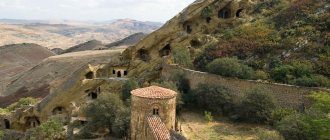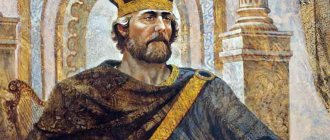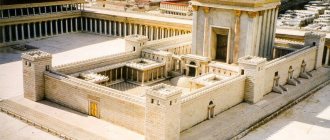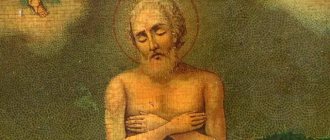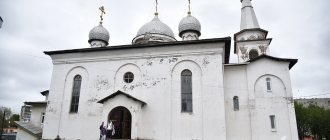Multiplying love. Venerable David of Gareji
On May 20, the Georgian Orthodox Church celebrates the memory of the Venerable Fathers John of Zedazni and his twelve disciples - the “second apostles” of Georgia. Coming from Syria in the 6th century, they became the successors of the feat of Saint Equal-to-the-Apostles Nino in the Christian enlightenment of Iberia and the pioneers of monastic construction on Georgian soil. And a few days later, on Thursday after the Ascension of Christ, May 24, a moving celebration will be held of the Venerable David of Gareji - according to legend, the beloved disciple of the Venerable John, the founder of the great shrine of Georgia - the David-Gareji Lavra. By the providence of God, St. David is becoming increasingly famous in Russia, largely thanks to the activities of the Moscow Church of the Life-Giving Trinity on Pokrovka, where this saint has been especially revered for many years.
By apostolic call
In Tbilisi, in the altar of the Patriarchal Cathedral of Tsminda Sameba - the Most Holy Trinity - a small round smooth stone of dark ocher color with reddish inclusions is kept in a reliquary. This is the miraculous shrine of the Georgian Orthodox Church - the Stone of Grace. The following legend is associated with him.
It was the 6th century from the Nativity of Christ. Several monks approached the foot of the mountain in the north-west of Jerusalem (from the era of the Crusades it would be known as the Mount of Joy), having made a difficult journey from a distant land called Sakartvelo, or Iberia. The elder who led the pilgrims suddenly said to his companions: “I, a sinner, will not dare to walk on the earth where the Lord’s feet have trod.” Having dismissed the disciples, he did not go further, and when the time came to go back, he picked up three simple stones from the ground, believing in his soul that he had taken them as if from the tomb of Christ. At this time, an Angel appeared to the Patriarch of Jerusalem in a dream and said that one of the pilgrims “by his faith took away all the grace from Jerusalem.” The patriarchal walkers caught up with the monks and took away two stones, and left one, conveying to the elder the words of the patriarch: “I give you one part for your desert, take this stone as a grace, as a memory and as a reminder of your faith.”
This touching legend, the material evidence of which Orthodox Georgia still worships to this day, tells the story of the great saint of the Georgian Church, one of the founders of Georgian monasticism - St. David of Gareji.
The Monk David was among the twelve Syrian fathers who came to Georgia in the middle of the 6th century with their teacher, the Monk John, who became the educator of the eastern part of the country – Kartli. According to legend, the Mother of God Herself sent the hermit John to the land of Iberia to continue the work of Equal-to-the-Apostles Nino. Having received in a dream the order of the Most Holy Theotokos to choose twelve disciples as his companions, he decided to rely entirely on the Providence of God and chose them by lot. Shio of Mgvim, David of Gareji, Anthony of Martkop, Thaddeus of Stepantsminda, Stefan of Hir, Isidore of Samtavi, Michael of Ulumbia, Pyrrhus of Brettia, Zenon of Ikaltoi, Aviv of Nekres, Jesse of Tsilkan and Joseph of Alaverdi - all of them subsequently received their middle names from the places where they founded holy monasteries or occupied bishop's chairs. From the name of Mount Zeda-Zadeni near Mtskheta, which the Monk John chose as his place of residence and founded the first monastery there, he himself began to be called John of Zedazni.
What ancient spiritual heritage nourished these new apostles? They grew up among Syrian monasticism, which occupies a special place in the history of Christian asceticism. There are different views of specialists on this issue, but now many are ready to admit that the ideal of monasticism and the monastic lifestyle in its original form, even ahead of Egypt and Palestine, originates from the Eastern Syrians. In the 4th–6th centuries, many monasteries and large monastic centers operated throughout Syria, attracting numerous pilgrims and followers. At this time, a large ascetic-theological school arose in Edessa, which had a significant influence on the formation of monastic communities. At the same time, it was in Syria that stylites arose - a unique type of individual asceticism, which in turn also contributed to the formation of monasteries near the places where the stylites labored - for example, the beautiful and majestic monastery of Kalat-Siman is associated with the name of the first stylite - St. Simeon († 389) . The future Abba David of Gareji probably retained for the rest of his life the memory of how, leaving his native Antioch and going to Georgia, their teacher brought his children to the younger follower of Saint Simeon - Simeon the Stylite of Divnomountain, and he gave them a blessing.
It must be said that monastic missionary work was a very common phenomenon in Syria. The preaching of Christianity in the East - not only in Georgia, Armenia, but also in Mongolia and China - was almost always the merit of the Syrians. Until approximately the middle of the 5th century, the Georgian Church was under the jurisdiction of the Antioch Patriarchate. Georgian youths studied at theological schools of Antioch and Nisibia. In Syria, people from Iberia lived in vast monastic settlements on the Black Mountain. There is information that the first translation of the books of the Old Testament into Georgian was made from Syriac manuscripts.
With and without a teacher
What else could St. David’s memory of his first steps in a new land preserve? The life of St. John of Zedazni tells how travelers approaching the ancient capital of Georgia, Mtskheta, were greeted with great honor by the clergy and people, led by Catholicos of Kartli Eulalius; how they bowed to the shrines of the Svetitskhoveli Cathedral, among which was the Robe of the Lord, kept in secret; how they went around Eastern Georgia, preaching and, by the grace of God, performing miracles and healings...
After some time, Abba John chose Mount Zadeni near Mtskheta as their place of residence. The mountain had a bad reputation: previously there was a pagan temple here, and the monks had to work hard to cleanse it of evil spirits through prayer and fasting (see Matt. 17:21) and turn it into a lot of peaceful monastic deeds. Pilgrims began to flock to this first monastery on this land, many of them joined the monastic brethren - the monastery grew, taking on the form of a monastery, with life under the leadership of one abbot and spiritual father, with obediences distributed among the brethren.
One day, says the Life, the Monk John received a message from above that it was time for him to let his spiritual children go - they would disperse throughout Georgia to found their own monasteries and increase the preaching of Christianity.
Thus, David and his disciple Lucian first settled on Mount Mtatsminda near Tbilisi, building in it, following the example of St. John, a small cave and a chapel. Every Thursday they went down to the city and preached. The Life of Saint David tells that once the fire-worshipping pagans bribed a pregnant woman so that she would point to David as a seducer. At the trial, the monk touched her stomach with his staff and ordered the child to say the name of her father. According to legend, after the name of the culprit was announced, the slanderer gave birth to a stone in pain. Grieving over what had happened, David offered a prayer, and on Mount Mtatsminda he poured a spring, the water of which heals the childless and restores women's health. The source still exists today, and countless generations of women have already received gracious help from it. On the spot where the simple chapel of St. David once stood, a temple was built, which was called Mamadaviti (“Father David”), but it also did not survive. The current church was built here at the end of the 19th century.
Soon the monks decided that they should completely withdraw from the world. They found a desert area in Kakheti, on the slope of the Gareji mountain range, about 70 kilometers southeast of Tbilisi. From this moment begins the history of the great shrine of Georgia - the David-Gareji Lavra, until the 20th century, the largest spiritual and cultural center in the Caucasus.
Desert Fathers
...Water is one of the first necessary gifts of God to man. But the waters did not pass through the Gareji mountains (see Ps. 103:10). The Gareji desert is dry, harsh, in summer it burns with heat of fifty degrees, in winter the frost reaches minus thirty, precipitation occurs only a few times a year. Apparently, everything was like this many centuries ago: The Life of St. David tells that, having come to Gareji, the ascetics each carved out a stone bed for themselves in the small natural caves of the mountain, prayed in the open air, ate grass, roots and milk, which was given by the wild fallow deer with their cubs who came to them, they drank rainwater, collecting it in depressions carved into the rock.
And in our time, Metropolitan Andrei (Gvazava) of Gori and Aten, who in the 1990s was the abbot of the revived David-Gareji Lavra, recalled: “The living conditions in the monastery were difficult: there was never water there, both drinking and for domestic needs. there was none - they collected rainwater using ancient tanks...”
Through the prayers of the Monk David, a holy spring arose here, but of an extremely ascetic nature: it later received the poetic name “Tears of David” - in fact, it is water oozing little by little through the thickness of the rocks in one of the caves.
Soon the hermits had their first church, carved into the rock and consecrated in honor of the Transfiguration of the Lord. The patron of this small temple was the Rustavi nobleman Bubacar, who believed in Christ after the miraculous healing of the monk and was baptized by him along with all his household.
As happened most often in the history of monasticism, the ascetics could not remain in their solitude for long. People seeking salvation began to come to them and settle nearby in caves. The first monastery was formed - the one that is now called the Lavra of St. David: many cells carved into the mountain slope.
Nearby, David's followers began to build new monasteries. Dodo of Gareji, with the blessing of his teacher, founded the Dodos-Rka monastery (in Georgian - “branch of Dodo”) in the name of the Most Holy Theotokos. Lucian, according to legend, is the Natlismtsemeli (“Baptist”) monastery in the name of the Holy Prophet John the Baptist. The monasteries were organized according to the Syrian cenobitic charter; Anchorites, who shunned all communication, labored alongside them. By the end of the saint's life, about two thousand disciples had gathered around him.
When the hour of his death was revealed to the elder, he gathered all the inhabitants of Gareja and said goodbye to them. The Monk David reposed on Thursday after the Ascension of the Lord and was buried in the Transfiguration Church of the David-Gareji Lavra. The Monk Lucian later rested there as well. Already in the 6th century, the Georgian Orthodox Church canonized David and Lucian as saints. For centuries, their graves were especially revered and were a place of pilgrimage. There is no tradition of finding relics in Georgia; in 2000, they opened the tomb of St. David of Gareji, made sure that the relics were in place, washed them, took a small particle and left everything intact. The Monk David rests peacefully under a bushel near the altar of the ancient Church of the Transfiguration of his monastery.
Lavra in history
For centuries, monastic life did not fade away in the David Lavra. Externally, the monastery changed - it grew with cave cells, terraces, connecting bridges... The lavra acquired its modern appearance in the 9th century, when it was completed by the Monk Hilarion Kartveli (822/3–875/6), who also erected new churches on the territory of the monastery complex. The greatest flourishing of David-Gareji occurred in the 11th–13th centuries - during the period of revival after the invasion of the Seljuk Turks. Then there were new invasions and devastations, including terrible ones: in 1615, on Easter night, the Persian Shah Abbas I massacred all the Gareji monks who had gathered for service at the small Church of the Resurrection of Christ. Tradition has variously preserved the number of martyrs - from six hundred to six thousand people, but it is known that after this tragic event the shrine was practically empty, and life subsequently continued in only three of the twenty monasteries. However, the authority of the “Georgian Thebaid” as an educational center and bearer of the spiritual ideal for all of Georgia was preserved.
During Soviet times, in 1923, the Gareji Lavra was closed. Since the late 1940s, a military training ground was located on the territory of the complex, as a result of which many rock churches, frescoes and epigraphic monuments were damaged or completely lost. The Lavra began to gradually recover in the 1970s, and monastic prayer returned there in the 1990s. The first inhabitant and vicar of the Lavra of St. David was Irakli (in monastic vows David) Makharadze, who was the caretaker of the museum-reserve located here, an architect by training, who took the priesthood and monasticism - now His Eminence, Metropolitan of Alaverdi.
Today Gareji unites about twelve temple ensembles. The grandiose monastery complex stretches for almost 25 kilometers, as if cutting through the Gareji Ridge, along which the border between Georgia and Azerbaijan passed in Soviet times. Some of the unique structures ended up on foreign territory, and neighbors have so far shown no desire to return Georgia’s heritage.
The most famous now and attracts numerous pilgrims is the Dodos-Rka monastery, with preserved ancient wall inscriptions in different languages, painted with extraordinary art; the active monastery of Natlismtsebeli with the cave temple of John the Baptist, which remembers the disciples of St. David, and, possibly, the Abba himself; Tetri-Udabno monastery, which was built during the heyday of Gareji in the 11th–12th centuries and preserved evidence of the unique school of fresco painting that existed here.
Venerable David of Gareji in Moscow
Despite the changing political circumstances, the Russian and Georgian Churches have always had many points of contact. So the Georgian saint of the first centuries of Christianity, the Venerable David of Gareji, miraculously, at the end of the twentieth century, found his “home” in Moscow, which became the Church of the Life-Giving Trinity on Gryazekh, which stands on Pokrovka, next to Chistoprudny Boulevard.
According to the rector of the Trinity Church, Archpriest John Kaleda, it all began in the 1990s with the unique missionary work of O.V. Shvedov, elder of the Church of the Transfiguration of the Lord in Tushino, where Father John also served: a great connoisseur and admirer of Georgian saints, Oleg Vasilyevich regularly brought water to Moscow from the spring of St. David on Mount Mtatsminda in Tbilisi, and became the initiator of prayers to the saint in his church. And soon cases of miraculous healing of women’s ailments and deliverance from infertility forced even inveterate skeptics to believe in the power of the saint’s intercession.
Father John transferred the tradition of prayer to the Monk David to the Trinity Church on Pokrovka when he was appointed its rector. Prayer services began to be served every week. We first ordered a small analogue icon of the saint for the church - at that time the only one in Moscow, and subsequently raised funds for a large hagiographic icon. The author of both icons was the icon painter Nina Mikhailovna Nosova (who later took monastic vows with the name Tikhon, a resident of the Stefano-Makhrishchi stauropegic monastery).
In the temple there is also another icon of the saint - a gift from the governor of the David-Gareji Lavra, and a wonderfully written image of the Monk John of Zedazni and his twelve disciples, donated by the governor of the Svetitskhoveli monastery, Archimandrite Seraphim. The parishioners of the Trinity Church did not remain in debt and, in turn, sent their offering to the Georgian saint - an embroidered cover on his tomb in the Church of the Transfiguration of the Lord. They worked on the cover for several years under the guidance of specialists, in particular, Irina Andreevna Kesler, artistic director of the gold embroidery workshop of the Alekseevsky Stavropegic Monastery. When the cover was ready, experts praised this work as a worthy continuation of the tradition of ancient Russian gold embroidery art. His Holiness Catholicos-Patriarch of All Georgia Ilia II also highly appreciated the work of Muscovites.
Thus, bypassing all spatial, temporal and other boundaries, the humble monk, Saint David of Gareji continues the work for which he lived and offered his prayers on the blessed land of Sakartvelo - the work of multiplying love.
Photo: Vladimir Khodakov, Ekaterina Orlova
Also presented are photographs from the website of the Church of the Life-Giving Trinity on Gryazekh https://www.triradosti.ru/
By apostolic call
In Tbilisi, in the altar of the Patriarchal Cathedral of Tsminda Sameba - the Most Holy Trinity - a small round smooth stone of dark ocher color with reddish inclusions is kept in a reliquary. This is the miraculous shrine of the Georgian Orthodox Church - the Stone of Grace. The following legend is associated with him.
It was the 6th century from the Nativity of Christ. Several monks approached the foot of the mountain in the north-west of Jerusalem (from the era of the Crusades it would be known as the Mount of Joy), having made a difficult journey from a distant land called Sakartvelo, or Iberia. The elder who led the pilgrims suddenly said to his companions: “I, a sinner, will not dare to walk on the earth where the Lord’s feet have trod.” Having dismissed the disciples, he did not go further, and when the time came to go back, he picked up three simple stones from the ground, believing in his soul that he had taken them as if from the tomb of Christ. At this time, an Angel appeared to the Patriarch of Jerusalem in a dream and said that one of the pilgrims “by his faith took away all the grace from Jerusalem.” The patriarchal walkers caught up with the monks and took away two stones, and left one, conveying to the elder the words of the patriarch: “I give you one part for your desert, take this stone as a grace, as a memory and as a reminder of your faith.”
This touching legend, the material evidence of which Orthodox Georgia still worships to this day, tells the story of the great saint of the Georgian Church, one of the founders of Georgian monasticism - St. David of Gareji.
The Monk David was among the twelve Syrian fathers who came to Georgia in the middle of the 6th century with their teacher, the Monk John, who became the educator of the eastern part of the country – Kartli. According to legend, the Mother of God Herself sent the hermit John to the land of Iberia to continue the work of Equal-to-the-Apostles Nino. Having received in a dream the order of the Most Holy Theotokos to choose twelve disciples as his companions, he decided to rely entirely on the Providence of God and chose them by lot. Shio of Mgvim, David of Gareji, Anthony of Martkop, Thaddeus of Stepantsminda, Stefan of Hir, Isidore of Samtavi, Michael of Ulumbia, Pyrrhus of Brettia, Zenon of Ikaltoi, Aviv of Nekres, Jesse of Tsilkan and Joseph of Alaverdi - all of them subsequently received their middle names from the places where they founded holy monasteries or occupied bishop's chairs. From the name of Mount Zeda-Zadeni near Mtskheta, which the Monk John chose as his place of residence and founded the first monastery there, he himself began to be called John of Zedazni.
What ancient spiritual heritage nourished these new apostles? They grew up among Syrian monasticism, which occupies a special place in the history of Christian asceticism. There are different views of specialists on this issue, but now many are ready to admit that the ideal of monasticism and the monastic lifestyle in its original form, even ahead of Egypt and Palestine, originates from the Eastern Syrians. In the 4th–6th centuries, many monasteries and large monastic centers operated throughout Syria, attracting numerous pilgrims and followers. At this time, a large ascetic-theological school arose in Edessa, which had a significant influence on the formation of monastic communities. At the same time, it was in Syria that stylites arose - a unique type of individual asceticism, which in turn also contributed to the formation of monasteries near the places where the stylites labored - for example, the beautiful and majestic monastery of Kalat-Siman is associated with the name of the first stylite - St. Simeon († 389) . The future Abba David of Gareji probably retained for the rest of his life the memory of how, leaving his native Antioch and going to Georgia, their teacher brought his children to the younger follower of Saint Simeon - Simeon the Stylite of Divnomountain, and he gave them a blessing.
It must be said that monastic missionary work was a very common phenomenon in Syria. The preaching of Christianity in the East - not only in Georgia, Armenia, but also in Mongolia and China - was almost always the merit of the Syrians. Until approximately the middle of the 5th century, the Georgian Church was under the jurisdiction of the Antioch Patriarchate. Georgian youths studied at theological schools of Antioch and Nisibia. In Syria, people from Iberia lived in vast monastic settlements on the Black Mountain. There is information that the first translation of the books of the Old Testament into Georgian was made from Syriac manuscripts.
With and without a teacher
What else could St. David’s memory of his first steps in a new land preserve? The life of St. John of Zedazni tells how travelers approaching the ancient capital of Georgia, Mtskheta, were greeted with great honor by the clergy and people, led by Catholicos of Kartli Eulalius; how they bowed to the shrines of the Svetitskhoveli Cathedral, among which was the Robe of the Lord, kept in secret; how they went around Eastern Georgia, preaching and, by the grace of God, performing miracles and healings...
After some time, Abba John chose Mount Zadeni near Mtskheta as their place of residence. The mountain had a bad reputation: previously there was a pagan temple here, and the monks had to work hard to cleanse it of evil spirits through prayer and fasting (see Matt. 17:21) and turn it into a lot of peaceful monastic deeds. Pilgrims began to flock to this first monastery on this land, many of them joined the monastic brethren - the monastery grew, taking on the form of a monastery, with life under the leadership of one abbot and spiritual father, with obediences distributed among the brethren.
One day, says the Life, the Monk John received a message from above that it was time for him to let his spiritual children go - they would disperse throughout Georgia to found their own monasteries and increase the preaching of Christianity.
Thus, David and his disciple Lucian first settled on Mount Mtatsminda near Tbilisi, building in it, following the example of St. John, a small cave and a chapel. Every Thursday they went down to the city and preached. The Life of Saint David tells that once the fire-worshipping pagans bribed a pregnant woman so that she would point to David as a seducer. At the trial, the monk touched her stomach with his staff and ordered the child to say the name of her father. According to legend, after the name of the culprit was announced, the slanderer gave birth to a stone in pain. Grieving over what had happened, David offered a prayer, and on Mount Mtatsminda he poured a spring, the water of which heals the childless and restores women's health. The source still exists today, and countless generations of women have already received gracious help from it. On the spot where the simple chapel of St. David once stood, a temple was built, which was called Mamadaviti (“Father David”), but it also did not survive. The current church was built here at the end of the 19th century.
Soon the monks decided that they should completely withdraw from the world. They found a desert area in Kakheti, on the slope of the Gareji mountain range, about 70 kilometers southeast of Tbilisi. From this moment begins the history of the great shrine of Georgia - the David-Gareji Lavra, until the 20th century, the largest spiritual and cultural center in the Caucasus.
Prayers
Troparion, tone 4
Your labors were then dissolved by streams of tears, / now you stand before our Lord in prayer, / as with tears you sowed and with joy reaped the fruits, revived in the desert. / Oh, David, my radiance ra // and the representative of our souls
Kontakion, tone 8
From the Syrian sources you ascended, O bright star, / and you illuminated the Gareji desert with the radiance of the Spirit: / as with your coming you created a monastic paradise, / having grown words in the desert great vertograd./ For this reason, do not leave to keep it,// Beloved David.
Kontakion, tone 4
From Mesopotamia you ascended, an all-bright star,/ and went into the desert of Gareji,/ and from there, with your appearance, like paradise,/ from the plantings of the saints, the plantings of words vegetate,// about them there is no end Pray, blessed David.
